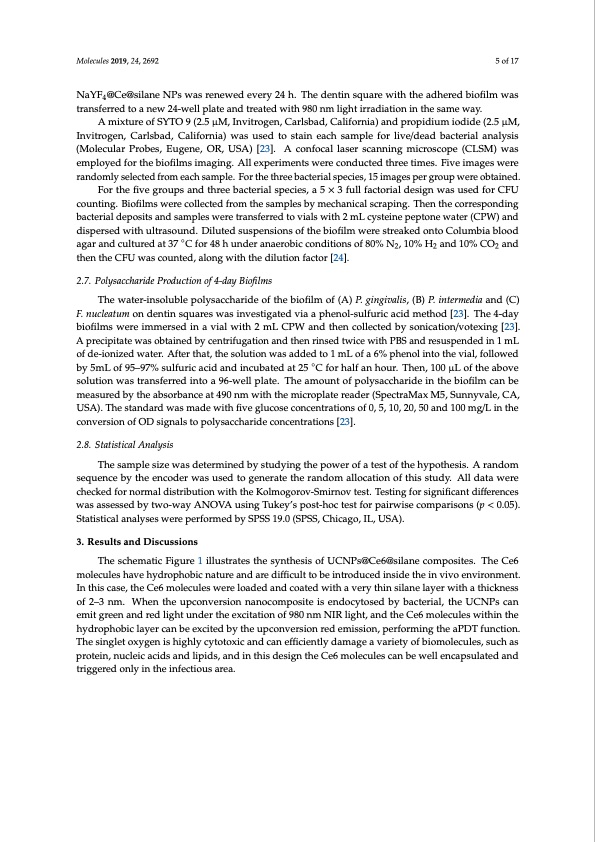
PDF Publication Title:
Text from PDF Page: 005
Molecules 2019, 24, 2692 5 of 17 NaYF4@Ce@silane NPs was renewed every 24 h. The dentin square with the adhered biofilm was transferred to a new 24-well plate and treated with 980 nm light irradiation in the same way. A mixture of SYTO 9 (2.5 μM, Invitrogen, Carlsbad, California) and propidium iodide (2.5 μM, Invitrogen, Carlsbad, California) was used to stain each sample for live/dead bacterial analysis (Molecular Probes, Eugene, OR, USA) [23]. A confocal laser scanning microscope (CLSM) was employed for the biofilms imaging. All experiments were conducted three times. Five images were randomly selected from each sample. For the three bacterial species, 15 images per group were obtained. For the five groups and three bacterial species, a 5 × 3 full factorial design was used for CFU counting. Biofilms were collected from the samples by mechanical scraping. Then the corresponding bacterial deposits and samples were transferred to vials with 2 mL cysteine peptone water (CPW) and dispersed with ultrasound. Diluted suspensions of the biofilm were streaked onto Columbia blood agar and cultured at 37 ◦C for 48 h under anaerobic conditions of 80% N2, 10% H2 and 10% CO2 and then the CFU was counted, along with the dilution factor [24]. 2.7. Polysaccharide Production of 4-day Biofilms The water-insoluble polysaccharide of the biofilm of (A) P. gingivalis, (B) P. intermedia and (C) F. nucleatum on dentin squares was investigated via a phenol-sulfuric acid method [23]. The 4-day biofilms were immersed in a vial with 2 mL CPW and then collected by sonication/votexing [23]. A precipitate was obtained by centrifugation and then rinsed twice with PBS and resuspended in 1 mL of de-ionized water. After that, the solution was added to 1 mL of a 6% phenol into the vial, followed by 5mL of 95–97% sulfuric acid and incubated at 25 ◦C for half an hour. Then, 100 μL of the above solution was transferred into a 96-well plate. The amount of polysaccharide in the biofilm can be measured by the absorbance at 490 nm with the microplate reader (SpectraMax M5, Sunnyvale, CA, USA). The standard was made with five glucose concentrations of 0, 5, 10, 20, 50 and 100 mg/L in the conversion of OD signals to polysaccharide concentrations [23]. 2.8. Statistical Analysis The sample size was determined by studying the power of a test of the hypothesis. A random sequence by the encoder was used to generate the random allocation of this study. All data were checked for normal distribution with the Kolmogorov-Smirnov test. Testing for significant differences was assessed by two-way ANOVA using Tukey’s post-hoc test for pairwise comparisons (p < 0.05). Statistical analyses were performed by SPSS 19.0 (SPSS, Chicago, IL, USA). 3. Results and Discussions The schematic Figure 1 illustrates the synthesis of UCNPs@Ce6@silane composites. The Ce6 molecules have hydrophobic nature and are difficult to be introduced inside the in vivo environment. In this case, the Ce6 molecules were loaded and coated with a very thin silane layer with a thickness of 2–3 nm. When the upconversion nanocomposite is endocytosed by bacterial, the UCNPs can emit green and red light under the excitation of 980 nm NIR light, and the Ce6 molecules within the hydrophobic layer can be excited by the upconversion red emission, performing the aPDT function. The singlet oxygen is highly cytotoxic and can efficiently damage a variety of biomolecules, such as protein, nucleic acids and lipids, and in this design the Ce6 molecules can be well encapsulated and triggered only in the infectious area.PDF Image | Anti-Biofilm Property of Bioactive Upconversion Nanocomposites

PDF Search Title:
Anti-Biofilm Property of Bioactive Upconversion NanocompositesOriginal File Name Searched:
molecules-24-02692.pdfDIY PDF Search: Google It | Yahoo | Bing
Cruise Ship Reviews | Luxury Resort | Jet | Yacht | and Travel Tech More Info
Cruising Review Topics and Articles More Info
Software based on Filemaker for the travel industry More Info
The Burgenstock Resort: Reviews on CruisingReview website... More Info
Resort Reviews: World Class resorts... More Info
The Riffelalp Resort: Reviews on CruisingReview website... More Info
| CONTACT TEL: 608-238-6001 Email: greg@cruisingreview.com | RSS | AMP |